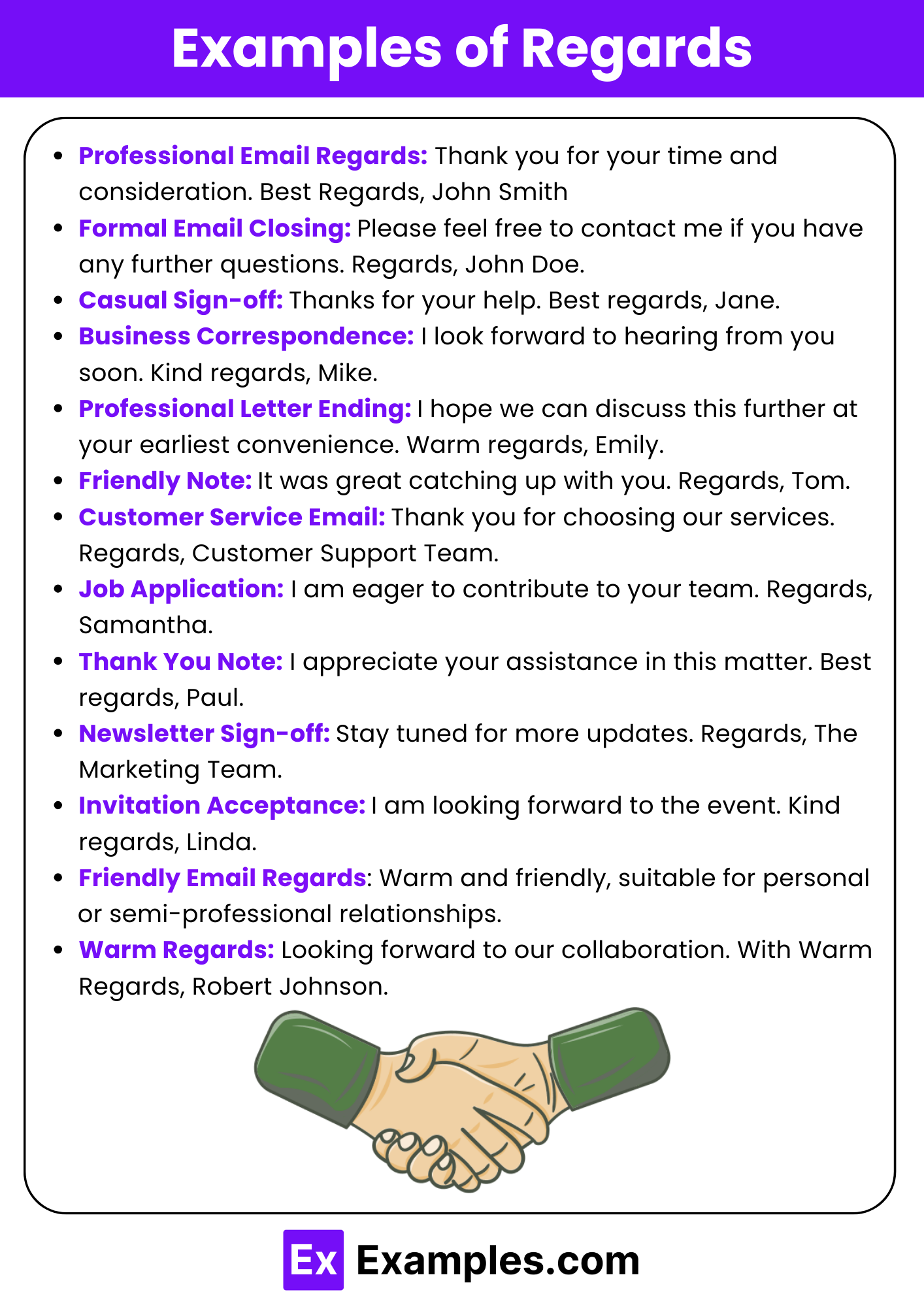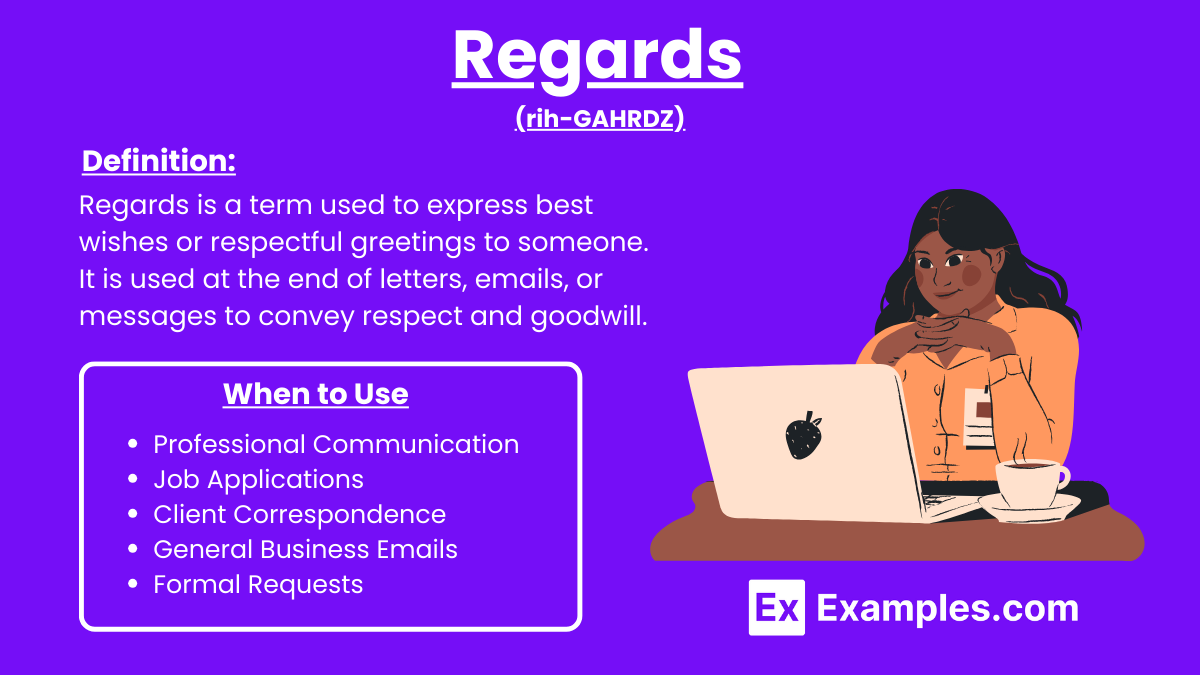30+ Regards Examples
When closing professional emails, choosing the right sign-off is crucial. “Regards” is one of the most commonly used email sign-offs due to its balance of formality and warmth. Understanding the nuances of “Regards” can help ensure your message is received positively, whether you’re addressing concerns like “Can a Company Fire You after a Notice,” discussing “Outside Work,” or crafting the perfect “Out-of-Office Message.” Using the right closing phrase can significantly impact how your communication is perceived in a professional setting.
What is Regards?
Regards is a polite closing phrase used in emails and letters to convey respect and goodwill towards the recipient. It balances professionalism and warmth, making it suitable for various formal and semi-formal communications.
Examples of Regards

- Best regards
- Kind regards
- Warm regards
- Sincere regards
- With regards
- Respectful regards
- Fond regards
- With warm regards
- With sincere regards
- Kindest regards
- Warmest regards
- Best personal regards
- Professional regards
- Highest regards
- Friendly regards
- With best regards
- In high regards
- My regards
- Gracious regards
- With heartfelt regards
Regards in Sentence Examples
- Formal Email Closing: Please feel free to contact me if you have any further questions. Regards, John Doe.
- Casual Sign-off: Thanks for your help. Best regards, Jane.
- Business Correspondence: I look forward to hearing from you soon. Kind regards, Mike.
- Professional Letter Ending: I hope we can discuss this further at your earliest convenience. Warm regards, Emily.
- Friendly Note: It was great catching up with you. Regards, Tom.
- Customer Service Email: Thank you for choosing our services. Regards, Customer Support Team.
- Job Application: I am eager to contribute to your team. Regards, Samantha.
- Thank You Note: I appreciate your assistance in this matter. Best regards, Paul.
- Newsletter Sign-off: Stay tuned for more updates. Regards, The Marketing Team.
- Invitation Acceptance: I am looking forward to the event. Kind regards, Linda.
Email Regards Examples
1. Professional Email Regards Examples
Best Regards – Usage: Commonly used in professional and formal settings.
Example: “Thank you for your time and consideration. Best Regards, John Smith”
Kind Regards – Usage: A polite and slightly less formal way to close an email.
Example: “I look forward to hearing from you soon. Kind Regards, Emily Johnson”
Sincerely – Usage: Very formal, often used in official and business correspondence.
Example: “Please let me know if you need any further information. Sincerely, Mark Thompson”
Regards – Usage: Simple and neutral, suitable for both formal and informal contexts.
Example: “Thanks for your assistance. Regards, Sarah Lee”
2. Friendly Email Regards Examples
Best Wishes – Usage: Warm and friendly, suitable for personal or semi-professional relationships.
Example: “I hope you have a great weekend! Best Wishes, Jane Doe”
Warm Regards – Usage: Conveys warmth and friendliness, ideal for closer acquaintances.
Example: “It was great catching up with you. Warm Regards, Alex Brown”
Take Care – Usage: Informal, often used when writing to friends or family.
Example: “Talk to you soon. Take Care, Linda Green”
Cheers – Usage: Casual and friendly, often used in informal and semi-professional settings.
Example: “Thanks for the update! Cheers, Mike Adams”
3. Casual Email Regards Examples
Best – Usage: Very casual, suitable for informal communication.
Example: “Looking forward to our meeting. Best, Amy Watson”
Thanks – Usage: Informal, best used when you are thanking the recipient.
Example: “Thanks for your help with this project. Thanks, David Brown”
Later – Usage: Very informal, suitable for close friends or colleagues.
Example: “See you at the game. Later, Chris Taylor”
4. Formal Email Regards Examples
Respectfully – Usage: Very formal, often used in official and legal correspondence.
Example: “I look forward to your response. Respectfully, Dr. Alice King”
Yours Faithfully – Usage: Formal, used when you don’t know the recipient’s name.
Example: “Please let me know your thoughts. Yours Faithfully, Michael Clark”
Yours Truly – Usage: Formal, used in professional and business emails.
Example: “I appreciate your assistance. Yours Truly, Rachel Martinez”
Warm Regards Examples
Warm Regards – Usage: Conveys warmth and friendliness, ideal for closer acquaintances.
Example: “It was great catching up with you. Warm Regards, Alex Brown”
Warmest Regards – Usage: A more affectionate variation, suitable for close colleagues or friends.
Example: “Thank you for your support. Warmest Regards, Jessica Davis”
With Warm Regards – Usage: Formal yet friendly, suitable for semi-professional and personal communications.
Example: “Looking forward to our collaboration. With Warm Regards, Robert Johnson”
Warmest Wishes – Usage: Expresses a high level of friendliness and warmth, ideal for personal connections.
Example: “Wishing you all the best. Warmest Wishes, Olivia Green”
Warm Regards and Best Wishes – Usage: Combines warmth with good wishes, suitable for both professional and personal contexts.
Example: “Hope you have a wonderful holiday season. Warm Regards and Best Wishes, Emily White”
With Warmest Regards – Usage: Emphasizes warmth and sincerity, perfect for closer relationships.
Example: “Thanks for everything you do. With Warmest Regards, Michael Carter”
When to Use Best Regards
Professional Communication – Use “Best Regards” when communicating with colleagues, clients, or business partners in a formal or semi-formal context.
Example: “Thank you for your prompt response. Best Regards, John Smith”
Job Applications – End cover letters and follow-up emails to potential employers with “Best Regards” to maintain a professional tone.
Example: “I look forward to the opportunity to discuss my application further. Best Regards, Emily Johnson”
Client Correspondence – When emailing clients or customers, “Best Regards” maintains a respectful and courteous tone.
Example: “Please let me know if you need any additional information. Best Regards, Mark Thompson”
Networking – Use “Best Regards” when following up with new contacts or connections after networking events.
Example: “It was a pleasure meeting you at the conference. Best Regards, Sarah Lee”
General Business Emails – Suitable for day-to-day business communications, such as updates, inquiries, and coordination.
Example: “Thanks for your assistance with the project. Best Regards, Jane Doe”
Formal Requests – Appropriate for formal requests or official communications within a professional setting.
Example: “Could you please send the report by end of the day? Best Regards, Robert Johnson”
Professional Thank-You Notes – Use “Best Regards” when sending thank-you emails for professional favors, advice, or assistance.
Example: “Thank you for your valuable insights. Best Regards, Jessica Davis”
Follow-Up Emails – Ideal for following up on meetings, discussions, or previously sent information.
Example: “Following up on our previous conversation, I wanted to check in on the status. Best Regards, Michael Carter”
What does “Best Regards” mean?
“Best Regards” is a polite, professional sign-off suitable for various emails, including a job application and resignation letter.
When to use “Kind Regards”?
Use “Kind Regards” in semi-formal contexts, such as a reminder email or an unhappy resignation letter.
Is “Warm Regards” appropriate for a job application?
Yes, “Warm Regards” can be used if the job application context is friendly but still professional.
Can “Best Regards” be used in a resignation letter?
Absolutely, “Best Regards” is a respectful way to close a resignation letter.
What’s the difference between “Best Regards” and “Kind Regards”?
“Best Regards” is more formal, while “Kind Regards” is slightly more friendly, suitable for reminder emails and unhappy resignation letters.
What’s a friendly alternative to “Best Regards”?
“Warm Regards” or “Kind Regards” are friendly alternatives, perfect for a reminder email.
Is “Best Regards” suitable for a reminder email?
Yes, “Best Regards” is appropriate for professional reminder emails.
Can “Regards” be used in an unhappy resignation letter?
Yes, “Regards” is neutral and professional for an unhappy resignation letter.
What’s the best sign-off for a reminder email?
“Kind Regards” or “Best Regards” are ideal for a reminder email.
Is “Warm Regards” too informal for professional emails?
“Warm Regards” is appropriate for semi-formal contexts like reminder emails but less so for job applications.



